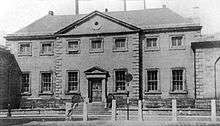Royal Hospital, Donnybrook
The Royal Hospital, Donnybrook (Irish: An tOspidéal Ríoga, Domhnach Broc) (also known as the Hospital for Incurables) is a hospital in Dublin, Ireland, founded in 1743. It was originally set up as a "hospital for incurables" to provide sufferers with food, shelter and relief from their distressing conditions.
History
In Georgian Dublin there were a number of charitable music societies that raised money to alleviate the suffering of the poor and ill. There was no system of public welfare, nor, until much later, any general policy on the part of the government to alleviate the problem of poverty, which pervaded the city at that time. One of these societies was the Dublin Charitable Musical Society of Crow Street, the leading light of which was Richard Wesley, 1st Baron Mornington, a politician (MP for Trim 1729-1746) and amateur violinist who took part in charity concerts. The society decided in 1743 to donate their funds to set up and support a hospital for incurables. A house for this purpose was rented in Fleet St., fitted up, and opened on 23 May 1744, with a nurse, a staff of doctors and surgeons, and 23 patients.[1]

The hospital moved to Townsend St. in 1753. In 1793 the hospital exchanged location with the Lock Hospital, which suited both hospitals, and moved to Donnybrook, a suburb of the city.
Notable physicians
At the foundation of the hospital the doctors were Francis Le Hunte (from County Wexford, a founder-member of the RDS), Constantine Barber and John Nichols.[1]
References
- Notes
- Sources
- Fleetwood, John F (1983). The History of Medicine in Ireland. Dublin: Skellig Press.
- Burke, Helen (2000). The Royal Hospital, Donnybrook. Dublin. ISBN 0-9521476-0-2.